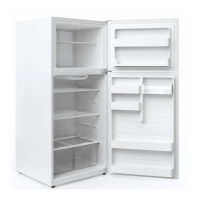Problem Problem Causes
Refrigerator door cannot be
properly closed.
There may be too much food in the freezer; or the refrigerator
may not be level.
Refrigerator is making loud
noises.
The food is not level in the unit.
The refrigerator is not balanced.
Refrigerator parts are not properly installed.
7.1 Summer Weather Tips
The refrigerator enclosure may emit heat during operaon, especially in the summer. This is
caused by the radiaon of the condenser. This is normal.
Moisture: Moisture can form on the cabinet surface between the doors and collect inside in
humid weather. This is not unusual. The moisture can be wiped away with a dry towel.
Buzz: A buzz can be generated by running the compressor, especially when starng up or
shung down.
8. ENERGY SAVING TIPS
Try not to open the door too oen, especially when the weather is humid. Once you open the
door, close it as soon as possible.
E
very now and then check to see if the appliance is sufficiently venlated (adequate air
circulaon behind the appliance).
In normal temperature condions, please arrange the thermostat at the middle seng. Before
loading the appliance with packages of fresh food, make sure that the food is cooled to room
temperature.
Frost or ice crystals on frozen food increase energy consumpon, so clean the appliance as soon
as the layer is 0.3-0.5cm thick.
If it is the outer condenser, the rear wall should always be clean and free of dust or any
impuries.
Alw
ays consider instrucons stated in the P
osioning and Energy Saving Tips secons, otherwise
the energy consumpon might be substanally higher.
The appliance should be located in the coolest area of the room, away from heat-
producing appliances or heang ducts and out of the direct sunlight.
Let hot foods cool to room temperature before placing them in the refrigerator.
Overloading the appliance forces the compressor to run longer. Foods that freeze too
slowly may lose quality or spoil.
Be sure to wrap foods properly, and wipe containers dry before placing them in
the
appli
ance. This cuts down on frost buildup inside the appliance.

